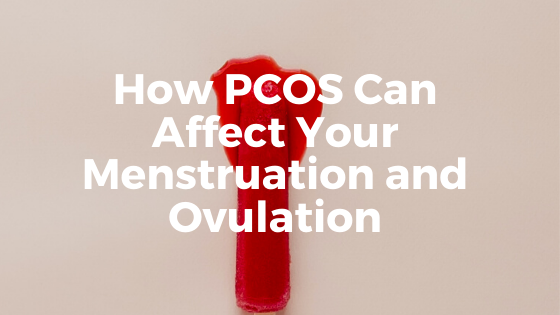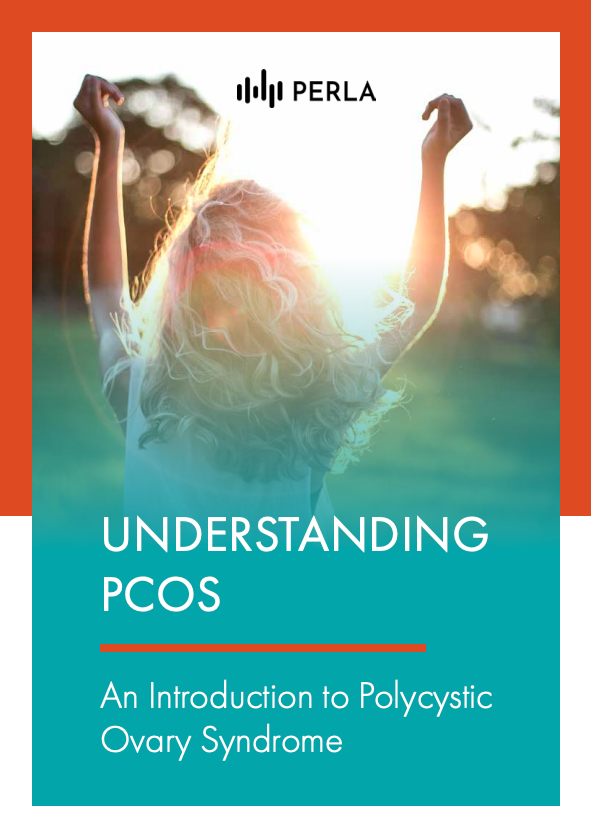Polycystic Ovary Syndrome (PCOS) can have many effects on your menstruation, such as missed or irregular periods, prolonged and heavy periods, as well as painful menstruation (dysmenorrhea). Your menstrual cycle is closely connected to your ovulation, and without regular ovulation, it can be difficult to become pregnant. Let’s dive deeper into the connection between menstruation and ovulation, and how it is connected to your fertility:
The Menstrual Cycle and PCOS
So what exactly happens during menstruation, and what is different when you have PCOS? To understand how PCOS affects your ovulation and period, let’s first understand how a normal menstrual cycle works:
A normal menstrual cycle involves ovulation (the release of an egg cell), followed by menstrual bleeding. During ovulation, the dominant follicle ruptures and the egg is released and travels through one of the fallopian tubes where it meets the sperm if there is any. If there is no ovulation, it is not possible to get pregnant.
The Journey of Egg Cells
From 1 to 2 million egg cells at birth, a girl will have about 300,000 eggs when she reaches puberty.1 In her reproductive years, around 300 to 500 of those eggs mature and progress through ovulation. By menopause, there are relatively few thousand egg cells left in the ovary. The remaining eggs, however, are of such poor quality that ovulation simply stops.
The sex hormones will begin to activate some of the immature egg cells at puberty. In each menstrual cycle, a number of eggs in one ovary become activated. Each ripening egg is contained in a fluid-filled sac called an ovarian follicle.
Although about 20 eggs are activated each cycle, only one follicle will become dominant (larger than others) and continue to ripen. The majority of follicles will disintegrate, a process known as atresia, leaving only one mature follicle to ovulate. When the mature egg is released, the ruptured follicle turns into a corpus luteum, which helps maintain a suitable environment in the uterus to support an implanted fertilized egg.2
If the egg is not fertilized 14 days after ovulation, the corpus luteum shrinks, and estrogen and progesterone levels fall. The thickened lining of the uterus is shed in menstruation and the whole cycle starts again.
The Role of Hormones in the Menstrual Cycle
Hormones play a key role in the menstrual cycle. They are chemical messengers that carry a message from one location in the body to another through the bloodstream. Hormones are essential in the menstrual process, and a complex sequence of hormonal events is necessary for ovulation to occur. The main hormones that regulate the menstrual cycle are:3
Gonadotropin-releasing hormone (GnRH) is produced by the hypothalamus (a small area in the brain) and stimulates the release of the hormones FSH and LH. These hormones are released in pulses and the secretion normally varies throughout the menstrual cycle. Slow GnRH pulses are responsible for FSH secretion whereas fast GnRH pulses favor the release of LH.
Follicle-stimulating hormone (FSH) is secreted from the pituitary gland (a pea-sized hormone gland in your brain) in response to GnRH. The release of FSH signals the start of the menstrual cycle. It stimulates the growth and maturation of the ovarian follicles as well as the secretion of estrogen by the ovaries.
Estrogen causes the lining of the uterus to thicken in preparation for pregnancy. The rising estrogen in the blood triggers a surge of LH, which triggers ovulation.
Luteinizing hormone (LH) causes the dominant follicle to rupture and release its egg into the fallopian tube towards the uterus in a process called ovulation. The high levels of LH secretion in women with PCOS stimulate the release of more than normal amounts of male hormones such as testosterone. This together with low levels of FSH contribute to poor egg development and failure to ovulate.
Progesterone is responsible for preparing the lining of the womb for implantation of the fertilized egg. After ovulation, the ruptured follicle becomes the corpus luteum, producing progesterone and estrogen.
The Impact of PCOS on the Menstrual Cycle
In women with PCOS, a variety of hormonal factors disrupt these processes, which can lead to anovulation or failure to ovulate.4
Studies have shown that in PCOS patients, GnRH secretion is relatively fast, resulting in high levels of LH secretion from the hypothalamus and lower than normal levels of FSH.5 Inadequate levels of FSH means follicles don’t mature, so ovulation does not take place. Even women with PCOS who have regular periods often have menstrual cycles without ovulation. Lack of ovulation is the root cause of many reproductive system problems that women with PCOS often face: menstrual irregularities and infertility.
If there is no ovulation, there is no production of progesterone. The endometrium (lining of the uterus) continues to thicken because of high levels of estrogen. If the estrogen level drops suddenly or if the endometrium becomes too thick and superficial layers break off, breakthrough bleeding can occur, which may be the reason for heavy and/or longer periods. Also, irregular periods or no periods at all can increase the risk for endometrial overgrowth (endometrial hyperplasia) or endometrial cancer.6
There are several different types of menstrual irregularities that can affect women with PCOS: 7
- Amenorrhea: no menstrual bleeding for 6 months or more
- Oligomenorrhea: menstrual bleeding at an interval of 35 days to 6 months
- Polymenorrhea: menstrual bleeding of more than once in 21 days
- Menorrhagia: abnormally heavy or prolonged bleeding (loss of over 80 milliliters of blood in one cycle)
If you are suffering from irregular or absent periods, or have general questions about the impact of PCOS on your menstruation and ovulation, make sure to reach out to your OB-GYN or reproductive endocrinologist. They can then work with you to support you with your concerns and help you manage your symptoms.
Sources:
1. Female Reproductive System. Cleveland Clinic. https://my.clevelandclinic.org/health/articles/9118-female-reproductive-system . Published 2019. Accessed June 16, 2020
2. Oliver R, Pillarisetty LS. Anatomy, Abdomen and pelvis, ovary corpus luteum. In: StatPearls. StatPearls Publishing; 2020. Accessed June 17, 2020. http://www.ncbi.nlm.nih.gov/books/NBK539704/
3. Holesh JE, Bass AN, Lord M. Physiology, ovulation. In: StatPearls. StatPearls Publishing; 2020. Accessed June 17, 2020. http://www.ncbi.nlm.nih.gov/books/NBK441996/
4. Toosy S, Sodi R, Pappachan JM. Lean polycystic ovary syndrome (PCOS): an evidence-based practical approach. J Diabetes Metab Disord. 2018 Dec;17(2):277-285.
5. Causes of PCOS | Center for Research in Reproduction. University of Virginia School of Medicine. https://med.virginia.edu/research-in-reproduction/patient-information/causes-of-pcos/. Accessed June 17, 2020.
6. Barbieri R. L et al. Patient education: Polycystic ovary syndrome (PCOS) (Beyond the Basics). https://www.uptodate.com/contents/polycystic-ovary-syndrome-pcos-beyond-the-basics#H4. Last Updated Mar 3 2020. Accessed June 30, 2020.
7. Balen A, Conway G, Homburg R, Legro R. Polycystic Ovary Syndrome: A Guide to Clinical Management. 1st ed. Oxforshire: Taylor & Francis Group; 2005.


